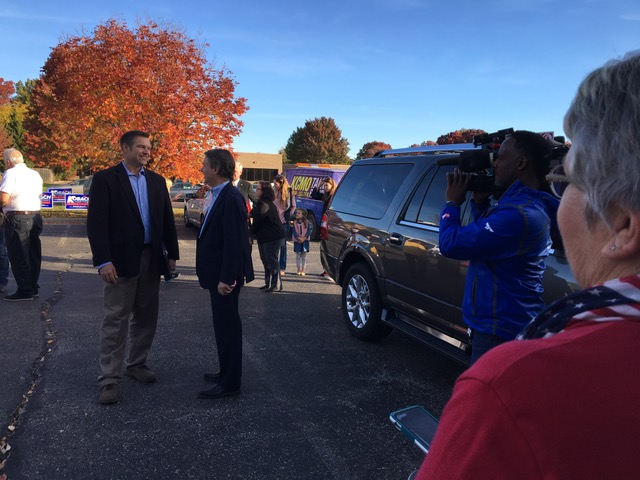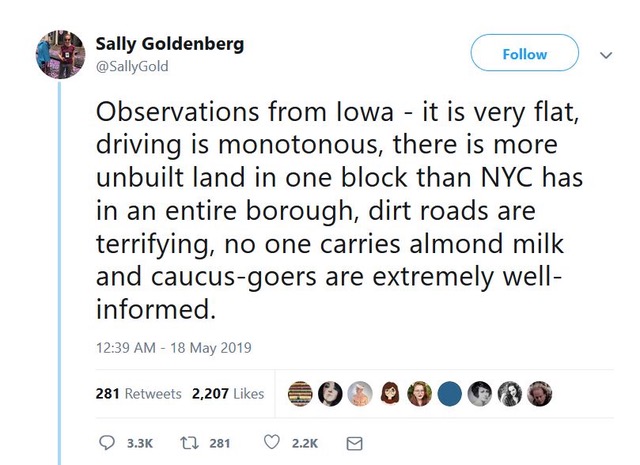We’re deep in the middle of the Iowa State Fair, the unofficial start of the next election cycle, and a time when all of us out here in the Midwest are preparing for our short time in the country’s limited attention span.
Candidates descend and with them, reporters who are tasked with getting the heartbeat of the “heartland,” one of the many clichés that have been used over and over since the 2016 election. Like a dispatch from a foreign country, these stories will quote Joe Farmer as he grabs the straps of his overalls and throws a bovine bon mot, “flyover” will be used as a descriptive geographic term, and large people will be eating pork chops-on-a-stick.
Our response: hogwash. (And trust us, we actually know how that smells.)
I’m a reporter, so I get it. It’s tough to get just a day or two to quickly take the pulse of a place, even as the press bus is idling outside the hotel and you’re trying to appease your editor. So in hopes of helping my sisters- and brothers-in-arms, I asked fellow Midwest reporters and others to come up with some advice.

Here are the top ten suggestions from various Twitter and Facebook discussions:
1 — The entire Midwest isn’t just Iowa. This is a very good point offered by Denis Beganovic of St. Louis, Missouri. All these big square states in the middle of the country may appear to you to look remarkably similar. We also understand that its easy to make this mistake, as the early deadline falls for Iowa’s February caucus. But please remember that each state was settled by different immigrant groups, has surprisingly different economies and cultures, and that there’s a sense of pride and place in each state.
A case in point: I live in Kansas City, which is cut in half by the state line, placing part of it in Missouri, the other in Kansas. This area was once the scene of pre-Civil War bloody skirmishes about Kansas’ entry to the union as a free state and Missouri’s inclusion as a slave state. These political forces are still at play today, as Kansas is now rising above the conservative tide, with a moderate Democrat elected governor last year. Missouri is mostly Trump territory, where Confederate flags are flown in the Ozarks and race plays out in the streets of towns like Ferguson.
2 – Please, as Oklahoma public radio reporter Jackie Fortier said, don’t open every story at a diner where old white guys are talking politics. Most of us don’t hang out there, or in any other clichéd places like the oldest bar in town.
“Branch out!” suggested Jill Rothenberg, a Colorado writer. “We have libraries! Grocery stores. Malls. Playgrounds.”
I’d add kids’ league games, brewpubs, grain elevators, Zumba classes — my 85-year-old mother in Nebraska is religious about her Zumba and her water aerobics.
“Avoid the morning coffee klatches dominated by old white men; or if you must, also go to a day care or school pick-up to talk to younger folks with kids,” wrote Sandra Fish, an Iowan now living in Colorado. “Or figure out where the old retired white women get coffee, too!”
3 – “Talk to communities of color in the Midwest,” said Serena Maria Daniels, a Detroit writer, “they’re often ignored by their local media, let alone national outlets.”
Yes, rural America is mostly white. But Hispanics are the fastest-growing segment in rural areas, according to the USDA. This is fueled, in part, by the low-income jobs at places like meatpacking plants, which employ mostly immigrants and refugees. That also means that poverty and aging are problems, and rural Americans now get the largest slice of federal food stamps.
In a hurry for a story? Stop in at a small town Mexican restaurant, because they’re everywhere, typically on Main Street. In 2011, the New York Times was already reporting that Hispanics are refilling the depopulating Plains and it was hard to find something other than Mexican food.
“There’s a great Mexican restaurant in Nevada, Iowa, for instance,” Fish wrote, “stop to talk to the folks who work and eat there.”
4 – Not everyone in the Midwest is a farmer. In fact, “most of our population lives in cities and suburbs,” said Kathy Kappes-Sum, a public school teacher.
Rural counties have grown slightly since 2000 “as the number of people leaving for urban or suburban areas has outpaced the number moving in,” the Pew Research Center reports. So while many people may be a generation or two removed from the farm, they’ve lived in population centers for a long time.
In fact, cities that grew the fastest since 2000 attracted people for what the Federal Reserve Bank of Kansas City called “natural amenities,” like mountains or warm weather, were next to larger cities, or had thriving industries.
So you might think of subbing out Joe Farmer with Steve the Soccer Dad.
5 – Just as we don’t all farm, each states’ economies are not simply centered around agriculture and in fact, may be driven by diverse industries. While the pictures and stories about deserted Main Street, Small Town USA, make for an easy get, they are as fashionable as a 1980s mullet.
“Not all rural is ag and not all ag is in the rural areas,” said Amy Mayer, an Iowa Public Radio reporter. “Iowa’s economy is about a third production agriculture, a third manufacturing and a third insurance. Ever hear a story about how all those insurance workers feel about the end of private healthcare? Me neither.”
For instance, the Kansas City Board of Trade, a grain commodity futures exchange, died in 2013, but there are sizable automotive, animal health and pet food industries here. Nearby Ottawa, Kansas, has a high number of workers in e-commerce, thanks to big warehouse distribution centers.
If you need a news peg, don’t forget the devastation brought on by massive flooding along the Missouri and Mississippi rivers this spring. Journalist Vicki Miller, who lives in southeast Nebraska, reminded us that some towns still don’t have fresh water and some communities may never recover.
“It would be a great year to follow up on the economic and human cost of the ongoing flooding and aftermath,” she said, “not just on ag but on the heart of our rural communities.”
6 – The larger economy will continue to be front and center this year for most folks in the Midwest, whether they are farmers struggling because of the Trump trade wars, low-income factory employees, minimum-wage service workers or really, any middle-class voter.
The second Gilded Age has come to ground here in the Midwest, and many areas will struggle in the coming years, particularly as automation grows, according to a new report by McKinsey Global Institute.
Significantly for the 2020 election, swing counties, such as many in the northern Midwest states, are struggling economically, another report suggests. These are counties that backed Obama, then flipped in 2016 to Trump.
7 – For the love of all that’s whole milk, when you’re at a city or suburban coffee shop, don’t assume that you can’t get soy or almond milk.
“No one should be shocked that ‘flyover states’ have great coffee places and great breweries, even outside the largest cities,” said Madeline Fox, a reporter who just moved from Kansas to Florida. “I get WORKED UP when reporters are shocked by local roasteries with — gasp — soy milk, or local breweries churning out a great stout.”
And don’t even get us started about the anger that arose when this New York reporter tweeted this:

“Thank you so much for your informative observations on the little known Flyover Kingdom,” Pete Saunders of Chicago shot back on Twitter.
8 – As referenced above, the term “flyover,” is the F-word.
“Go to neighborhoods that look like they could be in any city in America,” said Michelle Tyrene Johnson, a Kansas City writer. “Work neighborhoods of color, quirky millennial bars, non-descript suburbs. Don’t let the photo opp obscure the coverage.”
I’m heartened by the serious coverage coming out of the Iowa State Fair this year – most of the stories are focused on the issue of gun control, given the recent horrors in El Paso and Ohio. I understand that reporters must go where the candidates go. But covering a state fair as representative of the region is inaccurate and patronizing. I haven’t seen too much about the butter cow at the Iowa State Fair this year – and I’m glad, because that’s a cliché that’s been done a million times. Is it cute? Sure. Is it news? Nope.
9 – If we’ve learned anything from 2016, we should know that polls can be misleading. You must leave the newsroom, get out in the country, and talk to people.
The Atlantic recently covered this, quoting Washington reporters who suggested that polling should be used “as a starting place rather than a conclusion.”
Casey Kuhn, a Midwesterner now reporting out West, added that she doesn’t want to hear vox (a public radio term for man-on-the-street interviews) of voters being asked “Do you still support Trump after…”
“So ignorant!” Kuhn said. “Ask better (questions).”
Among the better questions are asking what a voter truly cares about – not just asking about which candidate she supports. Is he worried about health care, paying back his student debt, caring for his aging parents? Does she live paycheck-to-paycheck? Have both parties let them down?
10 – Kristofor Husted, a public media reporter in Missouri, said he respectfully offered this suggestion: “Maybe…don’t come?”
“At least every time,” Husted said. “Instead tap into the local reporters who can tell the stories better without a coastal elitist gaze.”
I agree with him, and encourage editors to hire local reporters. They can write with context and good sources, digging further into the real pieces of this place. To meet some great journalists working out here, contact the Between Coasts Forum, an effort started after the 2016 election by a group of writers concerned with coverage of middle America. Our next conference is in Lincoln, Nebraska, on October 18-19.
And if you still don’t get my message, I hereby assign you to watch the last two seasons of “Queer Eye,” both set in Kansas City. Maybe it was a makeover, but the Fab Five made us look pretty cool.
Editor’s note: This article first published on Lowe’s blog, Home(r) A Midwestern Memoir. It is reprinted with permission.
Peggy Lowe is a veteran reporter at KCUR, the NPR member station in Kansas City. She covers two national efforts — hub reporter for Marketplace, public media’s national business show, and an investigative producer with APM Reports. Before her return to the Midwest in 2011, she was a multimedia producer and writer at The Orange County Register in Southern California. Until 2005, she was in Denver, where she was a reporter for the late, great Rocky Mountain News, the Denver Post, KBCO, and the Associated Press. Lowe was the Mike Wallace Fellow for Investigative Reporting at the University of Michigan in 2008-2009.
